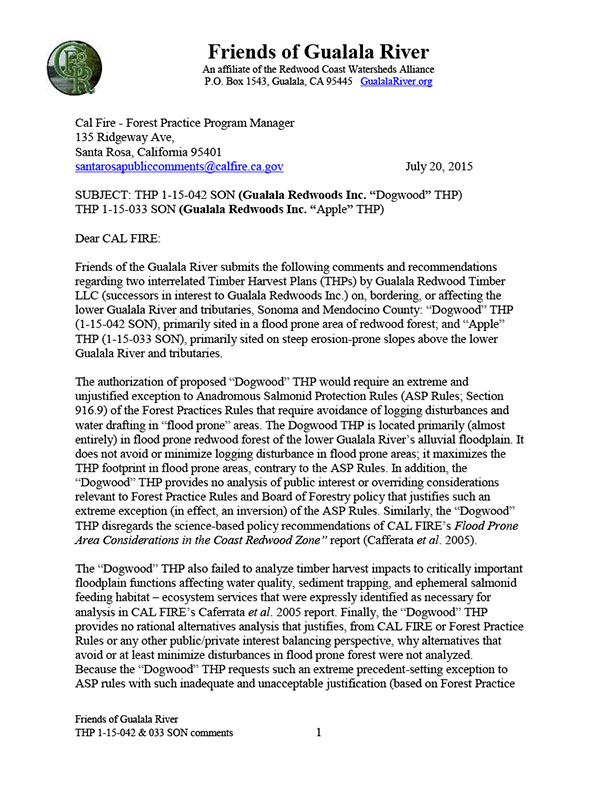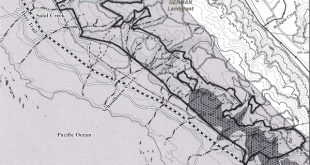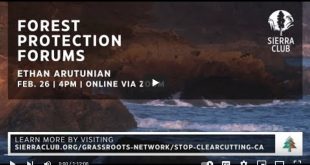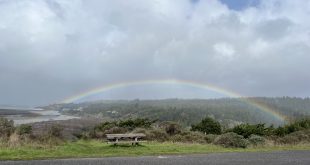Friends of Gualala River
An affiliate of the Redwood Coast Watersheds Alliance
P.O. Box 1543, Gualala, CA 95445 GualalaRiver.org
July 20, 2015
Cal Fire – Forest Practice Program Manager
135 Ridgeway Ave.
Santa Rosa, California 95401
santarosapubliccomments@calfire.ca.gov
SUBJECT: THP 1-15-042 SON (Gualala Redwoods Inc. “Dogwood” THP)
THP 1-15-033 SON (Gualala Redwoods Inc. “Apple” THP)
Dear CAL FIRE:
Friends of the Gualala River submits the following comments and recommendations
regarding two interrelated Timber Harvest Plans (THPs) by Gualala Redwood Timber
LLC (successors in interest to Gualala Redwoods Inc.) on, bordering, or affecting the
lower Gualala River and tributaries, Sonoma and Mendocino County: “Dogwood” THP (1-15-042 SON), primarily sited in a flood prone area of redwood forest; and “Apple” THP (1-15-033 SON), primarily sited on steep erosion-prone slopes above the lower Gualala River and tributaries.
The authorization of proposed “Dogwood” THP would require an extreme and unjustified exception to Anadromous Salmonid Protection Rules (ASP Rules; Section 916.9) of the Forest Practices Rules that require avoidance of logging disturbances and water drafting in “flood prone” areas. The Dogwood THP is located primarily (almost entirely) in flood prone redwood forest of the lower Gualala River’s alluvial floodplain. It does not avoid or minimize logging disturbance in flood prone areas; it maximizes the THP footprint in flood prone areas, contrary to the ASP Rules. In addition, the “Dogwood” THP provides no analysis of public interest or overriding considerations relevant to Forest Practice Rules and Board of Forestry policy that justifies such an extreme exception (in effect, an inversion) of the ASP Rules. Similarly, the “Dogwood” THP disregards the science-based policy recommendations of CAL FIRE’s Flood Prone Area Considerations in the Coast Redwood Zone” report (Cafferata et al. 2005).
The “Dogwood” THP also failed to analyze timber harvest impacts to critically important floodplain functions affecting water quality, sediment trapping, and ephemeral salmonid feeding habitat – ecosystem services that were expressly identified as necessary for analysis in CAL FIRE’s Caferrata et al. 2005 report. Finally, the “Dogwood” THP provides no rational alternatives analysis that justifies, from CAL FIRE or Forest Practice Rules or any other public/private interest balancing perspective, why alternatives that avoid or at least minimize disturbances in flood prone forest were not analyzed. Because the “Dogwood” THP requests such an extreme precedent-setting exception to ASP rules with such inadequate and unacceptable justification (based on Forest Practice Rules, relevant CAL FIRE scientific reports, sound science, and Board of Forestry policies), we strongly urge CAL FIRE to elevate this THP for policy review by the Board of Forestry and CAL FIRE Sacramento office.
The “Dogwood” THP also declined to provide even minimal current survey data for nearly all special-status fish, wildlife, and plant species (including state-listed and federally listed species) that either have occurred, or are known to occur, or are expected to occur, in the THP area. The “Dogwood” THP should either be suspended until such essential data are provided, or it should be denied without prejudice because the application is incomplete; alternatively, the application should otherwise be denied because it fails to adequately mitigate significant impacts to multiple special-status fish, wildlife, and plant species (including marbled murrelets, northern spotted owl, California red-legged frog, western pond turtle, coho salmon, steelhead, coast lily, California bellflower, and other species).
One of the most unacceptable public interest impacts of the proposed “Dogwood” THP is the location of “Unit 1” timber harvest in close proximity (effectively adjacent) to Gualala Point Regional Parks (Sonoma County Regional Parks), the primary public access and recreational area of the entire Gualala River. The logging of Unit 1, particularly without any mitigation proposed, would be an unacceptable public nuisance. The THP is negligent in failing to analyze obvious significant impacts of logging Unit 1 on campgrounds and visitors using Gualala Point Regional Park. In addition, the “Dogwood” THP fails to analyze recreational impacts (fishing, scenic views, boating) to visitor access to and enjoyment of the river bed protected by public trust (Section 4 of Article X of the California Constitution, California Code Sections 66478.1-66478.14)
Another grave defect in the “Dogwood” THP, and the related adjacent “Apple” THP with which it shares water drafting, roads, and THP boundaries, is its failure to avoid water drafting in flood prone areas as is required under the Anadromous Salmonid Protection Rules. The THPs merely claim, without explanation or evidence, that it is not feasible to avoid water drafting in protected flood prone areas. Yet the “Apple” THP discloses that GRI in the past has used alternative dust-suppressant road treatments and may do so again. The THPs fail to analyze impacts of drafting up to 25,000 gallons per day (GPD) from the Gualala River in drought years (like the last 2 and current year) when the river flows fall below critical levels. The THPs cite only a 2010 hydrologic study that assessed non-drought conditions (under significantly higher summer low flows) and concluded that water drafting less than 25,000 GPD would have no effects. That pre-THP report’s conclusion applied to the “Dogwood” and “Apple” THPs is unreasonable in drought conditions that may recur. Water drafting of this magnitude in a drought year would have significant impacts whenever the river flows are already below critical thresholds.
We are also concerned that the THPs likely have disregarded impacts to two known prehistoric Southern Pomo village sites, Kubahmoi and Kabētēyo, located “…near south bank Rockpile creek at its confluence with Gualala River” and “…near east bank Gualala River about a mile and a quarter upstream from confluence of Rock Pile Creek…”, respectively. One or both of these approximate locations, and their related camp sites (also named and historically recorded) are likely either within or near THP areas. The THPs do not disclose the potential impacts to these prehistoric villages to enable meaningful public comment (including living descendants of these Pomo villages). In contrast, CAL FIRE required recirculation of a timber conversion EIR upstream above the Gualala River because of deficiencies in analysis of timber conversions near but not even including prehistoric Pomo village sites. CAL FIRE must disclose (non-confidential published information), analyze and fully mitigate significant potential impacts to archaeological and cultural resources of outstanding significance like these prehistoric Pomo village sites. It should consult with expert archeologists and tribal historic preservation officers (Kashia, Manchester, and related southern Pomo tribes) regarding THP impacts and report their non-confidential conclusions for public review.
Conclusions and Recommendations
We strongly recommend that CAL FIRE suspend the “Dogwood” THP and require that
the applicant, GRT, resubmit a complete and adequate THP for public recirculation,
including:
- a rigorous and objective alternatives analysis that addresses flood prone area protection current special-status species surveys (not deferred post-permit surveys) acceptable to fish and wildlife agencies
- analysis of hydrology, geomorphic, and ecological impacts the flood plain and river (with emphasis on sediment, water quality, and salmonids)
- analysis of impacts to archaeological and cultural resources (non-confidential aspects)
- analysis of recreational impacts to Gualala Point Regional Park and river recreation under public trust access
- results of policy-level review by Board of Forestry and Sacramento CAL FIRE office, specifically addressing the THP’s requested major exceptions to Anadromous Salmonid Protection Rules for flood prone areas.
Thank you for your attention. We anticipate future CAL FIRE review and decisions in
the public interest, consistent with Board of Forestry policy and Forest Protection Rules.
Respectfully submitted,
Chris Poehlmann
President, Friends of the Gualala River
For the Board of Directors, Friends of Gualala River
Copies furnished:
California Department of Fish and Wildlife (Yountville)
Regional Water Quality Control Board, Region 1 (Santa Rosa)
NOAA Fisheries (Santa Rosa)
U.S. Fish and Wildlife Service (Arcata Fish & Wildlife Office)
Interested parties

Click on the image above to download a pdf version of the letter.
 Friends of Gualala River Protecting the Gualala River watershed and the species living within it
Friends of Gualala River Protecting the Gualala River watershed and the species living within it


